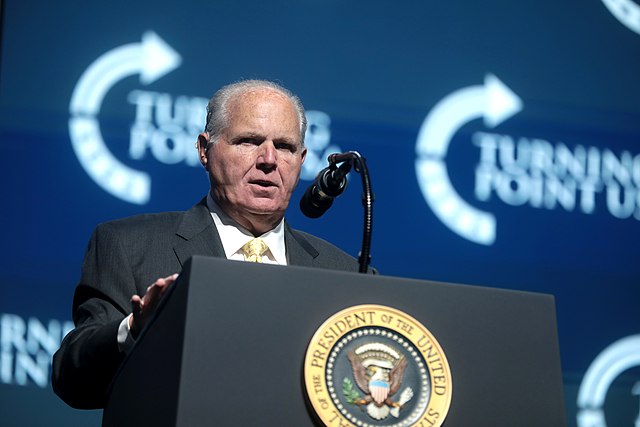Bring Back the Fairness Doctrine
A rise of bias in the media in recent decades has deeply fractured politics. We need to repair the damage that has been done.
Gage Skidmore / Wikimedia Commons
Pictured is Rush Limbaugh at the Student Action Summit in 2019.
In the 1960s and 70s, as an anchorman for CBS Evening News, Walter Cronkite was considered the most trusted man in America. Today, a journalist speaking on some of the most controversial issues in politics and still gaining all Americans’ trust is unimaginable.
If you look back in time through the 40 years since Cronkite went off the air, it is clear that something went wrong. During that time, trust in the media has dropped from around 70% of Americans trusting the media in the 1970s down to just 40% today. The source of this problem is quite clear: the 1987 repeal of the Fairness Doctrine.
In 1949, the Federal Communications Commission (FCC) created the Fairness Doctrine in order to keep the news in check. The policy was composed of two conditions for broadcasters that had to be fulfilled in order to receive broadcasting licenses. First, when giving any controversial or biased opinion on an issue, broadcasters had to show an alternative point of view. Second, broadcasters had to devote a reasonable amount of time to controversial issues of public importance.
The Fairness Doctrine kept American politics together, which is why it was so catastrophic when Ronald Reagan’s FCC repealed the policy in 1987.
The detrimental effects of this decision were seen immediately. In the year following the Fairness Doctrine’s repeal, far-right radio show host Rush Limbaugh attained national prominence. Over the next 34 years, he used his radio talk show as a platform to spew racist, sexist, homophobic, and xenophobic rhetoric, single-handedly splitting the country into the two different factual universes that we see today. His lies extend into our current circumstances — last February 2020, he claimed that COVID-19 was “the common cold,” mere weeks before it began to spread across the country.
Limbaugh passed away on February 17th, 2021. However, without intervention, other radio hosts such as Alex Jones and Sean Hannity will continue his destructive legacy with similarly divisive rhetoric and conspiracy theories.
If the Fairness Doctrine were to be put back in place today, it could restrict these hosts from giving a platform to right-wing conspiracy theories.
It would not end at radio talk shows either: local TV stations are required to obtain broadcast licenses in order to run, and so the Fairness Doctrine would apply to them as well. These stations are the main news source for twice as many Americans as radio talk shows are.
Americans also trust their local news stations: 45% trust reporting from local news, as opposed to just 31% trusting national news. However, there is a lot going on behind the scenes. These stations are not typically run independently, but rather owned by large corporations. Sinclair Broadcasting Group, for example, owns hundreds of local TV stations in 34 states across the country.
Sinclair does not have a history of using their power over these stations for good. Among other abuses of power, they have previously forced their stations to show “must run” segments, which typically provide viewers with extreme right-wing political opinions.
If the Fairness Doctrine were brought back today, it would force radio talk shows and local TV stations into showing the full truth on issues to their audience.
Let us not forget about the second part of the Fairness Doctrine, either. Mandating that these broadcasters devote time to issues of public importance is drastically necessary.
Broadcasters are driven by money, and the best way to profit is to keep viewers entertained. To do that means focusing on the most interesting and divisive issues instead of the most important ones. This is why we are seeing a nearly meaningless debate on the gender of Hasbro’s potato head toy, instead of issues that really matter. For instance, climate change, potentially one of the most catastrophic issues of the day, only took up 0.4% of all broadcasting time in 2020. It is just not something that people are led to care about.
Bringing back the Fairness Doctrine is an obvious choice. It will bring us one step closer to fixing these issues, but it is not the be-all-end-all for fixing American politics. The 24% of Americans who get their news from local TV and radio stations are as far as the Fairness Doctrine could affect, since these news sources are the only major ones requiring broadcast licenses. Network and cable TV, social media, and websites all cannot be regulated through the Fairness Doctrine. They do not use public broadcasting — instead, consumers pay for these services, so they cannot constitutionally be subject to the policy.
Yes, the Fairness Doctrine is not flawless, but it is the best that we can do. There is no perfect solution — American politics have been fractured down to the core. But that does not mean that we cannot try.
The Fairness Doctrine kept American politics together, which is why it was so catastrophic when Ronald Reagan’s FCC repealed the policy in 1987.
Rahm Rodkey is an Editor-in-Chief for 'The Science Survey.' He enjoys how journalistic writing is able to connect people on a global scale, and that it...

